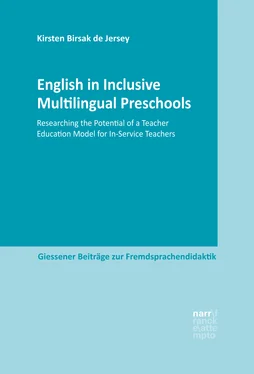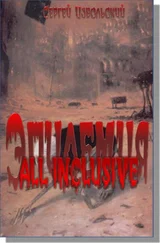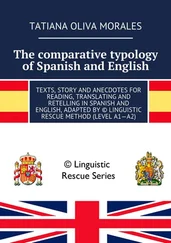Kirsten Birsak de Jersey - English in Inclusive Multilingual Preschools
Здесь есть возможность читать онлайн «Kirsten Birsak de Jersey - English in Inclusive Multilingual Preschools» — ознакомительный отрывок электронной книги совершенно бесплатно, а после прочтения отрывка купить полную версию. В некоторых случаях можно слушать аудио, скачать через торрент в формате fb2 и присутствует краткое содержание. Жанр: unrecognised, на английском языке. Описание произведения, (предисловие) а так же отзывы посетителей доступны на портале библиотеки ЛибКат.
- Название:English in Inclusive Multilingual Preschools
- Автор:
- Жанр:
- Год:неизвестен
- ISBN:нет данных
- Рейтинг книги:3 / 5. Голосов: 1
-
Избранное:Добавить в избранное
- Отзывы:
-
Ваша оценка:
- 60
- 1
- 2
- 3
- 4
- 5
English in Inclusive Multilingual Preschools: краткое содержание, описание и аннотация
Предлагаем к чтению аннотацию, описание, краткое содержание или предисловие (зависит от того, что написал сам автор книги «English in Inclusive Multilingual Preschools»). Если вы не нашли необходимую информацию о книге — напишите в комментариях, мы постараемся отыскать её.
English in Inclusive Multilingual Preschools — читать онлайн ознакомительный отрывок
Ниже представлен текст книги, разбитый по страницам. Система сохранения места последней прочитанной страницы, позволяет с удобством читать онлайн бесплатно книгу «English in Inclusive Multilingual Preschools», без необходимости каждый раз заново искать на чём Вы остановились. Поставьте закладку, и сможете в любой момент перейти на страницу, на которой закончили чтение.
Интервал:
Закладка:
human cognition is understood as originating in and fundamentally shaped by engagement in social activities. … Cognition cannot be removed from activity since it originates in and is framed by the very nature of that activity. … It takes prolonged and sustained participation in social activities that have a clear purpose … within specific social contexts. (Johnson & Golombek, p. 2011, p. 3)
Meanwhile a large body of research literature reports on the effectiveness of organising teacher education as participation in situ . Through this approach, teachers are supported to develop “the essential procedural knowledge to confront the realities of the classroom”. It also helps to avoid the “separation of subject matter knowledge (what to teach) from pedagogical knowledge (how to teach)” (p. 2; italics in original) but instead simultaneously develops the two closely related dimensions of the activity of teaching in an integrated way. This central role of the context has recently been confirmed by an action research study conducted with secondary English teachers in Germany:
… Contexts [in which teachers work] shape how and why teachers do what they do. Knowledge does not just develop by accumulating information, but is shared, negotiated and co-constructed through experience in the communities of practice in which the individual participates. Therefore, teacher education needs to create opportunities for teachers to reflect on the appropriateness of their theories of learning in their local contexts. (Müller Hartmann & Schocker, 2018a, p. 107)
The preschool teachers will experience in what ways English can be taught to young learners through being exposed to examples of ‘how it can be done’. Teachers may reflect on the appropriateness of what is happening in their classrooms, rather than just being exposed to a transmission-oriented approach in which “teachers learn about language, second language acquisition, and language use … separate from the pedagogical concepts, procedures, and activities that constitute the activity of actual teaching” (Johnson & Golombek, 2011, p. 2).
By locating the teacher education in an established teaching environment, an authentic situation is used for teachers to “connect the input to their own knowledge, experience and ongoing practice” (Freeman, 2001, p. 76). Poehner notes that it is not sufficient to
merely [expose] teachers to the latest theories and initiatives without providing the conditions (e.g., time, opportunities to practice, and feedback) required for them to be linked to – and to potentially improve – actual classroom practice, which is at the very heart of professional development. (Poehner, 2011, p. 189)
A further reason to organise teacher education in situ is that it is strategically important for teachers to experience how to overcome contextual constraints that may severely obstruct the implementation process. As my survey demonstrated, teachers experience their contexts of work as challenging and demanding (→ chapter 3). It affects their motivation, their available time and energy considerably when they attempt to meet a new challenge, as is the introduction of English in their groups. Situating the teacher education in the workplace of participating preschool teachers puts no undue extra demands on the teachers. Instead, teachers can integrate the new subject in the daily routines of their educational work.
The teacher education design also needed to consider a prevailing general reluctance of teachers to introduce English into the preschool context which my survey has also demonstrated (→ chapter 3). Through offering the teacher education in situ the preschool teachers would be able to directly experience the potential of learning English with their groups of learners. This would support them to make valid judgements on the benefits of implementing English in their context. If it worked with their group of learners, it would qualify as a credible experience that could directly affect their attitude in a positive way and would contribute to their developing skills and knowledge while taking part in the teaching process.
A further benefit of organising the teacher education project in situ means that teachers are able to work with their group of children: their familiarity with the context supports teachers’ confidence to actively participate in the lessons in cooperation with the teacher educator. It has been repeatedly reported in teacher development studies that when teachers develop their English teaching competences with the groups of children, which they are familiar with they feel competent and safe: “From their experience (they) know what works in the classroom and what does not. Hence, they are much more ready to depart from rules and take responsibility for their own actions” (Tsui, 2003, p. 29) if they encounter new challenges. As the preschool teachers have already developed a rapport with their children and can rely on their authority and classroom management, they “are better able to respond to student needs and classroom events that require decisions and actions because they have well-established routines, which they can call upon to respond to a variety of unanticipated events” (p. 38). Consequently, it is expected that initial inhibitions to experiment with introducing a new language will be reduced and instead a non-threatening environment for them to teach in will be established (Van Avermaet et al., 2006, p. 195). Only recently, in summarizing the insights of her review on empirical research on effective primary English teacher education, Dausend noted that
it has become visible how important it is for learning to take place in meaningful settings, even for teacher students at university level. They need ample opportunities and situations to experience themselves, to communicate, to discuss, to reflect on ideas and practical experience with other teacher students. (Dausend, 2017, p. 122)
5.4.2 Teacher education organised as participatory action research
The questionnaire survey I conducted at the beginning of my research identified a distinct gap between teachers’ general interest to introduce an English programme in preschools and a widespread perception of contextual constraints that might impede its implementation (→ chapter 3). The most effective approach to overcome these constraints would be to bridge this gap by encouraging preschool teachers to become part of a collaborative investigation in the process of teaching English in which they would be directly involved and would play an active part. After more than a decade of experiences with participatory action research, this approach to introduce innovations in educational contexts has come to be seen as “a powerful form of staff development” (Burns, 1999, p. 15). The practice of investigating change processes collaboratively in shared contexts of work was expected to promote “self-reflective enquiry within the social situations” in question (Carr & Kremmis, 1986, p. 162). As all of the teachers of the sample preschool would be participating in the action research project the educational purpose could be aligned with the contextual needs.
It is a unique feature of this research project that my sampling did not consist of a group of student teachers who would focus on their professional development in teaching English, but it entailed instead pedagogically experienced preschool teachers who were initially reluctant and hesitant to introduce English into their context in the first place. As action research “is highly contextualized within the personal daily workplace and provides a way to open up, question, and investigate the realities of the teaching situation” (Burns, 2009, p. 116), it seemed to be a suitable approach to involve preschool teachers to develop their professional competence in the field of teaching English to the children: “It can take your thinking in new directions and can be modified flexibly as you progress, as there are no fixed ‘rules’ about how the research process should proceed or what the outcome should be” (p. 116). Moreover, a motivating factor to take part in action research as a team might result from this approach:
Читать дальшеИнтервал:
Закладка:
Похожие книги на «English in Inclusive Multilingual Preschools»
Представляем Вашему вниманию похожие книги на «English in Inclusive Multilingual Preschools» списком для выбора. Мы отобрали схожую по названию и смыслу литературу в надежде предоставить читателям больше вариантов отыскать новые, интересные, ещё непрочитанные произведения.
Обсуждение, отзывы о книге «English in Inclusive Multilingual Preschools» и просто собственные мнения читателей. Оставьте ваши комментарии, напишите, что Вы думаете о произведении, его смысле или главных героях. Укажите что конкретно понравилось, а что нет, и почему Вы так считаете.











